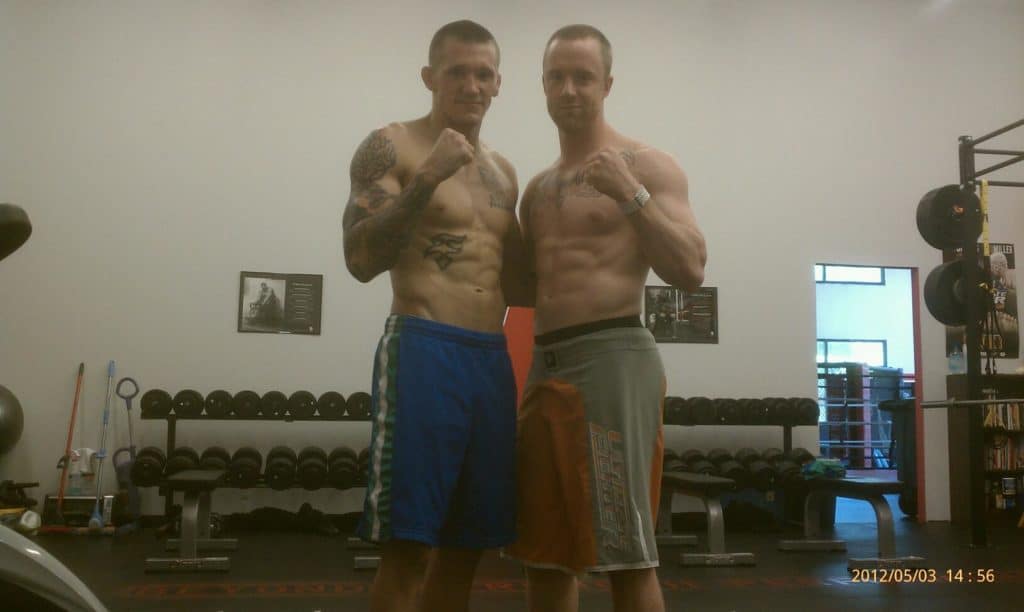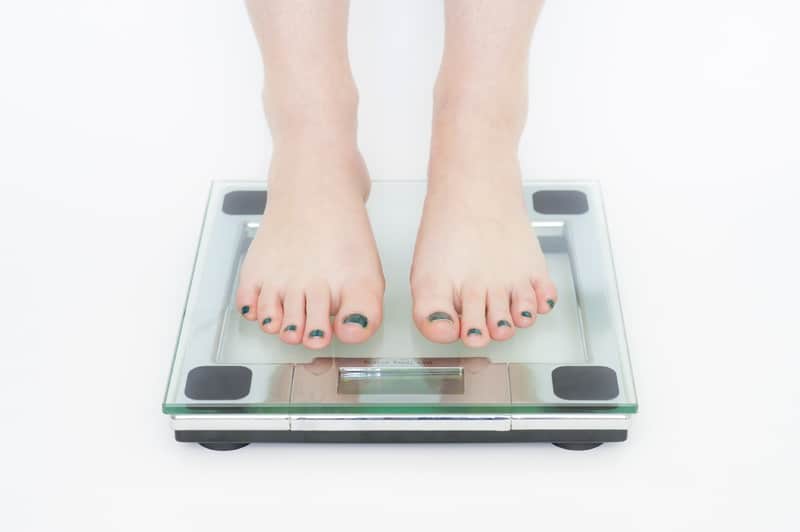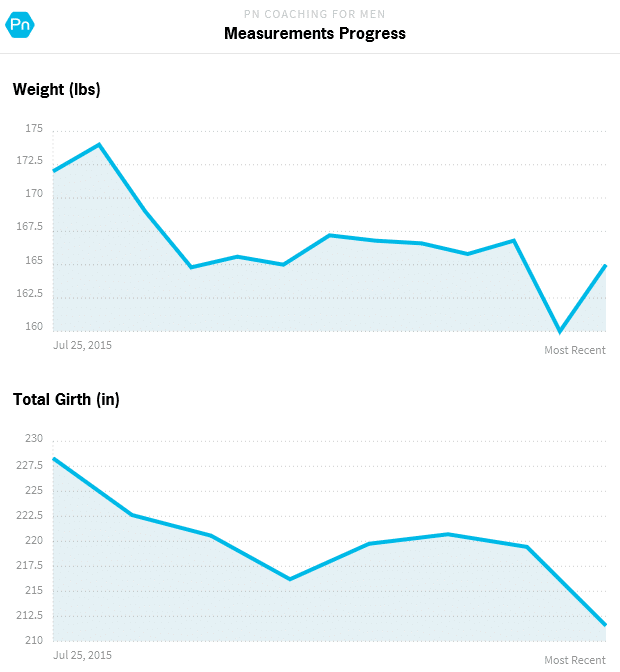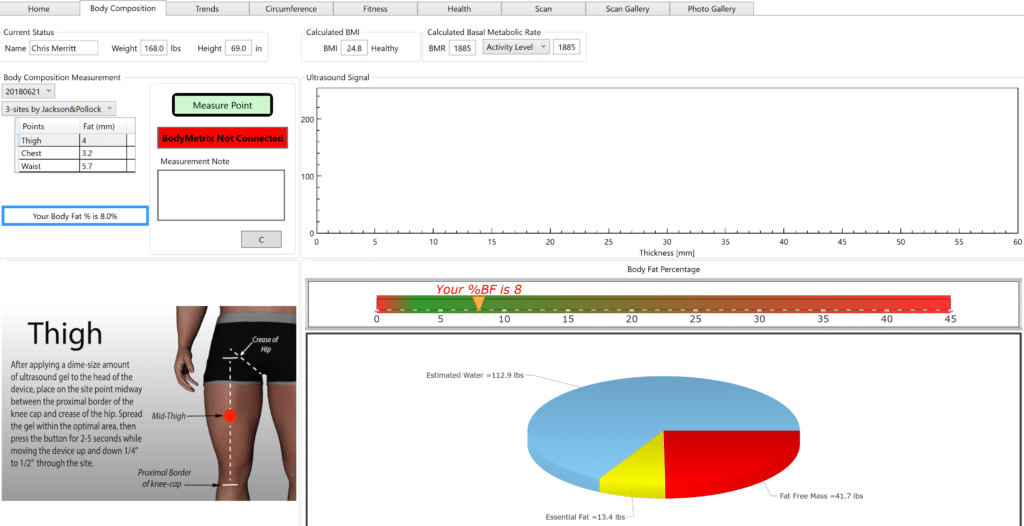The thing with working out and diet is that we just don’t see a difference in body composition in the day to day of it all. Or, sometimes we think we do but we’re incredibly critical of ourselves—confidence one day, disappointment and shame the next. And we all do it at some point, it’s our human nature.
Today’s post is an approach that I used to successfully squash this inner voice (mostly), get honest with myself about what was actually happening, have a pretty significant transformation, and maintain the results for over two years now.
First things first, credit for the ideas go to two sources: Josh Hillis, author of Fat Loss Happens on Monday and LoseStubbornFat.com, and Precision Nutrition, a nutrition education company that I have both worked with as a client and to become a certified coach. What follows is not directly taken from either, but it would be unjust of to act as if I pulled these ideas out of thin air.
The Backstory
I opened Beyond Strength Performance NOVA in October of 2011. Back then (like it was so long ago? LOL) I was very lean, and it came rather easily to me. Don’t get me wrong, I trained like a mad man, ate pretty well, and didn’t have a whole heck of a lot of stress in my life. I just thought nothing of it.

But as the business grew, so did the requirements of my time. As most business owners do in the beginning stages, I said yes to EVERYTHING. My training slid backwards, my nutrition became a mix of grabbing things on the go and long periods of no food followed by binging on the sub-par choices, my stress went through the roof, and, for the first time in my life, I became unhappy with the way I looked (my own judgement, and not a reflection of how I think anyone else should set the bar for themselves)…
By the summer of 2016 I had had enough. I decided it was time to sign up for a year of coaching with Precision Nutrition and go all in on taking my health, body composition, and (most importantly) my sanity back.

I was impressed by two major things in the process. One, I didn’t feel different, nor think that I looked different day to day. There were periods where I thought, “no way in hell is this working,” and almost quit following the process. I got bored with the simplicity of lessons and approach that Precision Nutrition employs—”This can’t be it, I’m more advanced than this,” I thought at different times throughout the year, even falling off almost completely a little over midway into the program, only to reengage and come back strong for the last 3-ish months.
The second thing was the way that we measured progress (or, potentially, lack thereof), which, in my opinion, is one of the most invaluable takeaways of the whole experience, and, unfortunately the one that most people fail to follow through on. This is what today’s post will be covering, albeit modified to the way that I currently use it today.
How to Track Body Composition (Without Going Insane)
I think it’s safe to say that most all of us have used the scale to track bodyweight at times throughout our health and training journey. It’s down one day (hooray, it’s working!) and up the next (abandon the ships, we need a new approach!). We can drive ourselves insane! But the scale isn’t a bad tool for tracking progress, it’s all in when and how we use it.

Both J0sh Hillis, in his book Fat Loss Happens on Monday, and Precision Nutrition, in their coaching program, utilize a multi-disciplinary approach to tracking progress.
Josh recommends weekly testing done on the same day of the week, relatively the same time, and the same conditions (for example, first thing in the morning after using the bathroom), changing the measure of tracking each week—maybe pictures on week one, the scale on week two, and circumference measurements on week three. As he says, if the scale is up but circumference is down and you’re digging the way you look, give it time.
Precision Nutrition had us do testing every other week, with circumference measurements and bodyweight being collected every time (twice a month), and pictures every other (once a month).
The success lies is in the similaritiy of the two approaches. Using multiple means to measure progress allows us to get a clearer picture of how we’re doing (pun not intended). While the scale might be up (ahhhhh!), the circumference measurements might be down (woohoo!). And if measurements keep trending downward, the scale is sure to eventually follow. Why is it up today? Who knows. Let’s just note the weight and see where we’re at the next time we measure (and no, not tomorrow…).
But what if the scale is up, circumferences are headed in the wrong direction, and we hate the way our pictures look this month? Has this been going on for multiple check-ins? In not, stay the course and see what happens next month. Progress isn’t always linear.

We’ve been having multiple check-ins headed in the wrong direction now? Okay, it’s time to get curious. How has our nutrition been? How has our training been? How has our sleep been? Stress levels? Looking at my results above you can see that midway point where I almost completely checked out. Was the program no longer working? Nope, it was I who was no longer working. Seeing those objective results headed in the wrong direction was all the motivation I needed to snap back in and crush the rest of the program, and onward through today.
I truly believe that had I not been tracking those things I would have continued to head in the wrong direction. Visibly, the results, good or bad, weren’t something I noticed day to day, but the consistent objective (bodyweight and circumference) and subjective (pictures) check-ins kept me honest about what was really going on throughout.
What (and when) I Measure Today
I don’t want to spend large chunks of my time obsessing over body composition anymore, so I use a very simplistic approach today. This approach keeps me honest with my nutrition, training, sleep, and stress management. Things aren’t always where I want them to be, but there’s never been a time where I’m dumbfounded as to why that is. And by staying aware of these measures, I’m able to make adjustment as needed and reign things back in before I’d ever be able to notice the changes from a purely subjective standpoint.
Circumference
I don’t want to invest the time to do all of the measurements I did with Pn (shoulders, upper arm, chest, waist, hip, thigh, calf), so I simply measure what I have found (for ME, personally) to be a consistent measure of total body composition, which is my waist. I simply measure the narrowest point, which for most people is just above their belly button, once a week. on Friday morning.
Bodyweight
We have a scale at the gym, and I actually jump on it all too often, BUT, I don’t tie any emotion to it. I know that I hover between 164-169 on any given day of the week. If I see it getting to 170 or above I’m never surprised as to why. Guess it’s time to cut back on the evening treats a little bit OR be cool with knowing that that’s all it is and I can adjust it back down by reigning things in when I’d like.
Sight & Pictures
This ones not for everyone, I know. In fact, no one needs to do any of this, but more to come on that in a bit… At this point I know how I look when my body composition is within the range of where I’d like it to be. Most of the time I can keep tracking by just seeing my midsection in the mirror from day to day, but I do occasionally take pictures. For instance, I started experimenting with gymnastic rings training for the summer and I wanted to see it would make a difference in my upper body build, so I took pictures back in May when I started. I’ll take updated ones, probably sometime in September, to compare. And yes, they were bathroom mirror selfies—I’m not ashamed to say it! And I know I said it’s hard to see change day to day, and that’s still true, but I have become very aware of how I look when I’m less than 10% body fat.
Body Fat Percentage
This is the one that I do the least, about once a quarter. We used to use InBody at the gym, but found it to be incredibly unreliable (and with a 10k pricetag, that just won’t work), so we switched to BodyMetrix™ last year.
From their website: The BodyMetrix™ System offers the same professional-grade ultrasound technology used by elite athletes and trainers. This high tech, cutting edge device allows you to quickly, easily and accurately make assessments. The BodyMetrix™System does all this without embarrassing or painful pinching. Assessments take only minutes and are not affected by hydration, exercise level or caffeine intake. Since the BodyMetrix™device can be plugged into your Windows or Mac desktop or laptop and Windows Pro tablets, you can make assessments anywhere.
Here’s a screenshot of my last reading from June of this year:
 As you can see, I can actually record circumferences, save pictures, and measure and track many other things right in the system, but I simply do my body fat every 3-4 months.
As you can see, I can actually record circumferences, save pictures, and measure and track many other things right in the system, but I simply do my body fat every 3-4 months.
What Should You Do?
As the kids say, you do you baby boo! Honestly, you don’t have to do a damn thing I just mentioned. I don’t want to ever put forward the idea that these measures are a representation of my self-worth, or anyone else’s, for that matter. But if, like me, you do want to improve your body composition, it is my belief that consistently checking in with your progress (or potentially, again, lack thereof) will allow you to get curious and make adjustments as needed, but most importantly, recognize the progress that you are making and yet may be very hard to see at this point in your transformation.
If you’d like to give something like this a go, I’d recommend being consistent with whatever it is you choose, and that might look something like this:
- Week 1: Body Fat %
- Week 2: Pictures
- Week 3: Circumference Measurements
- Week 4: Bodyweight
Are those the only measures? Absolutely not. Want to alternate objective and subjective measures? Try this approach:
- Week 1: Body Fat %
- Week 2: Pictures
- Wek 3: Circumference Measurements
- Week 4: Journaling (how you’re feeling with your progress and the process, mood, energy, motivation, reflection, etc…)
Whatever you do, enjoy the process, and if we can ever be of any help, we’re here!

